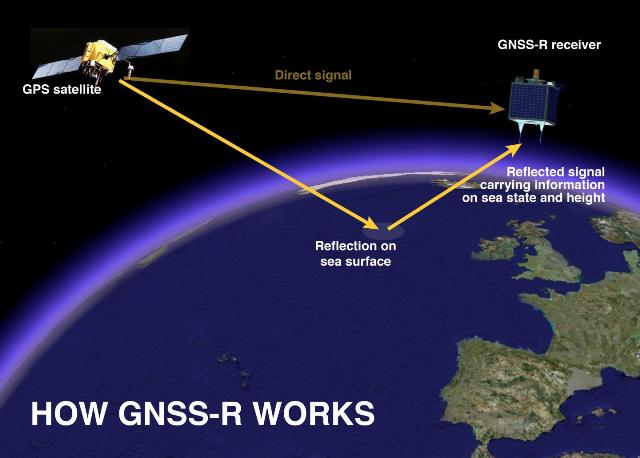Feb 23 2016
The GPS signal used for 'sat-navs' could help improve understanding of ocean currents, according to new research published in Geophysical Research Letters by National Oceanography Centre (NOC) scientists, alongside colleagues from the University of Michigan and Jet Propulsion Laboratory.
 The GNSS-R principle.Credit: Paolo Cipollini from the NOC
The GNSS-R principle.Credit: Paolo Cipollini from the NOC
As part of this research, sea surface height has been measured from space using GPS signals reflected off the sea surface for the first time. Information from these GPS signal reflections can be potentially used by scientists to monitor ocean currents by measuring the slopes currents cause in the ocean's surface.
Ocean surface height measurements are routinely made from space by radar altimeters, but this new study is the first that uses the GPS reflections. The data for this research was acquired from the TechDemoSat-1 satellite, launched in 2014 by Surrey Satellite Technology Ltd.
Dr Paolo Cipollini from NOC, who co-authored this research, said "the sea surface is not flat at all, especially when looked at over long distances. The largest 'bulges' are due to variations in the Earth's gravity field. On top of those there are smaller, shorter variations due to sea surface currents. We are really encouraged by our results since it demonstrates for the first time that we are able to map the overall sea surface height from space using the GPS-reflections technique. This leads us to think that in the near future we should be able to map currents from space by detecting even smaller variations in sea surface height."
GNSS-Reflectometry (GNSS-R) is the general term for reflectometry using navigation signals, including GPS as well as the European equivalent Galileo. The advantage of using GNSS-R is that it uses the GNSS transmitters already in orbit, and the lightweight, low-power receivers can be launched into space relatively cost-effectively. Existing satellite altimeters, although very accurate, are not in enough number to sample the ocean well at scales below 100 km. A constellation of GNSS-Reflectometry receivers would provide a thirty-fold improvement on the amount of data that could be gathered. Such a constellation will be launched in late 2016 as part of the NASA CYGNSS mission, to watch an animation of this follow video:
CYGNSS sampling
Dr Maria Paola Clarizia, a visiting scientist at NOC from University of Michigan, and the lead author of the paper, stressed that "the UK has been a pioneer in using GNSS reflectometry to measure ocean features, and the NOC has led the field in analysing the data."
Until recently we could only measure wind speed from satellite GNSS-R data, so this new ability to also observe sea-surface height is a real breakthrough - provided we can retrieve accurate heights. Our paper is a first step in that direction."
NOC's long involvement with research in GNSS-R has been led by Christine Gommenginger, the head of Satellite Oceanography at the NOC. Results published by NOC scientists in 2015 have already demonstrated the capabilities of spaceborne GNSS-R for ocean surface wind speed retrieval.